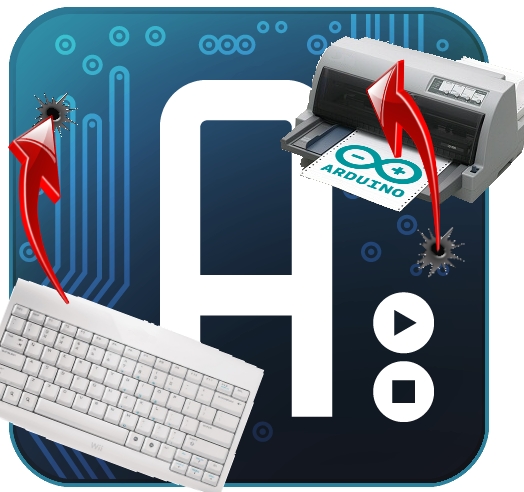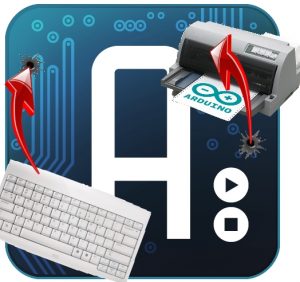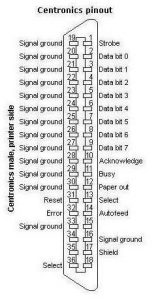
Arduino TypeWriter
This project shows how to recycle an old PS2 keyboard and a dot matrix printer (DB25) to make a typewriter using our Arduino Controller.
How it works:
The idea is to connect the keyboard to the printer with a basic and cheap interface, we have used Arduino because is a fast development board for this kind of projects. The board read the keyboard signals (use a data/clock system) and transform this info about the character to the printer.
Printer Connection:
Here I used old Desk-jet printer who has Centronics Parallel port for connection.
The figure shows pinout of Centronics Connector.The port has 36 pins, but here for our project we only use 10 pins out of all the pins.
- Data bit 0 – Data bit 7 (No:2 to No:9)-> Data pins were connected to Arduino Digital Pins 4 to 11 .
- Strobe (No:1) -> Strobe pin was connected to Arduino Digital Pin 12.
- Autofeed (No:11) -> Autofeed pin was connected to Arduino Digiatal Pin 13.
Key Board Connection:
I used my old PS2 Keyboard, Which has same port mentioned in my PS2-mouse tutorial. You may have any of the connector mentioned in figure like DIN5/DIN6.
- Connect your VCC and GND pins to Arduino VCC and GND pins.
- Connect KB.Data Pin to Arduino Digital Pin 2.
- Connect KB.Clk pin to Arduino Digital Pin3.
That’s it.You are ready with your Hardware setup.
Code :
#include <PS2Keyboard.h>
#include <string.h>
#include <stdio.h>
#define KBD_CLK_PIN 3
#define KBD_DATA_PIN 2
#define d0 4
#define d1 5
#define d2 6
#define d3 7
#define d4 8
#define d5 9
#define d6 10
#define d7 11
#define strobe 12
#define autofd 13
PS2Keyboard keyboard;
int caracter = 0;
byte key=0;
void setup()
{
keyboard.begin(KBD_DATA_PIN);
pinMode(d0, OUTPUT);
pinMode(d1, OUTPUT);
pinMode(d2, OUTPUT);
pinMode(d3, OUTPUT);
pinMode(d4, OUTPUT);
pinMode(d5, OUTPUT);
pinMode(d6, OUTPUT);
pinMode(d7, OUTPUT);
pinMode(strobe, OUTPUT);
pinMode(autofd, OUTPUT);
digitalWrite(autofd,HIGH);
digitalWrite(strobe,HIGH);
Serial.begin(9600);
delay(1000);
}
void transmit(int x)
{
if (x >= 128)
{
x = x – 128;
digitalWrite(d7,HIGH);
}
else
{
digitalWrite(d7,LOW);
}
if (x >= 64)
{
x = x – 64;
digitalWrite(d6,HIGH);
}
else
{
digitalWrite(d6,LOW);
}
if (x >= 32)
{
x = x – 32;
digitalWrite(d5,HIGH);
}
else
{
digitalWrite(d5,LOW);
}
if (x >= 16)
{
x = x – 16;
digitalWrite(d4,HIGH);
}
else
{
digitalWrite(d4,LOW);
}
if (x >= 8)
{
x = x – 8;
digitalWrite(d3,HIGH);
}
else
{
digitalWrite(d3,LOW);
}
if (x >= 4)
{
x = x – 4;
digitalWrite(d2,HIGH);
}
else
{
digitalWrite(d2,LOW);
}
if (x >= 2)
{
x = x – 2;
digitalWrite(d1,HIGH);
}
else
{
digitalWrite(d1,LOW);
}
if (x >= 1)
{
digitalWrite(d0,HIGH);
}
else
{
digitalWrite(d0,LOW);
}
digitalWrite(strobe,LOW);
delayMicroseconds(2);
digitalWrite(strobe,HIGH);
}
void loop()
{
if(keyboard.available())
{
byte c = keyboard.read();
Serial.println(c);
// byte c=Serial.read();
ascii(c);
if(c == 13)
{
Serial.println(key);
transmit(10);
}
else
{
Serial.println(key,HEX);
transmit(key);
}
// Serial.println(c,HEX);
}
}
void ascii(byte x)
{
switch(x)
{
case 0x1c:
{
key=0x41;
break;
}
case 0x32:
{
key=0x42;
break;
}
case 0x21:
{
key=0x43;
break;
}
case 0x23:
{
key=0x44;
break;
}
case 0x24:
{
key=0x45;
break;
}
case 0x2B:
{
key=0x46;
break;
}
case 0x34:
{
key=0x47;
break;
}
case 0x33:
{
key=0x48;
break;
}
case 0x43:
{
key=0x49;
break;
}
case 0x3B:
{
key=0x4A;
break;
}
case 0x42:
{
key=0x4B;
break;
}
case 0x4B:
{
key=0x4C;
break;
}
case 0x3A:
{
key=0x4D;
break;
}
case 0x31:
{
key=0x4E;
break;
}
case 0x44:
{
key=0x4F;
break;
}
case 0x4D:
{
key=0x50;
break;
}
case 0x15:
{
key=0x51;
break;
}
case 0x2D:
{
key=0x52;
break;
}
case 0x1B:
{
key=0x53;
break;
}
case 0x2C:
{
key=0x54;
break;
}
case 0x3C:
{
key=0x55;
break;
}
case 0x2A:
{
key=0x56;
break;
}
case 0x1D:
{
key=0x57;
break;
}
case 0x22:
{
key=0x58;
break;
}
case 0x35:
{
key=0x59;
break;
}
case 0x1A:
{
key=0x5A;
break;
}
case 0x0D:
{
key=0x09;
break;
}
case 0x29:
{
key=0x20;
break;
}
default:
{
}
}
}
#include <string.h>
#include <stdio.h>
#define KBD_CLK_PIN 3
#define KBD_DATA_PIN 2
#define d0 4
#define d1 5
#define d2 6
#define d3 7
#define d4 8
#define d5 9
#define d6 10
#define d7 11
#define strobe 12
#define autofd 13
PS2Keyboard keyboard;
int caracter = 0;
byte key=0;
void setup()
{
keyboard.begin(KBD_DATA_PIN);
pinMode(d0, OUTPUT);
pinMode(d1, OUTPUT);
pinMode(d2, OUTPUT);
pinMode(d3, OUTPUT);
pinMode(d4, OUTPUT);
pinMode(d5, OUTPUT);
pinMode(d6, OUTPUT);
pinMode(d7, OUTPUT);
pinMode(strobe, OUTPUT);
pinMode(autofd, OUTPUT);
digitalWrite(autofd,HIGH);
digitalWrite(strobe,HIGH);
Serial.begin(9600);
delay(1000);
}
void transmit(int x)
{
if (x >= 128)
{
x = x – 128;
digitalWrite(d7,HIGH);
}
else
{
digitalWrite(d7,LOW);
}
if (x >= 64)
{
x = x – 64;
digitalWrite(d6,HIGH);
}
else
{
digitalWrite(d6,LOW);
}
if (x >= 32)
{
x = x – 32;
digitalWrite(d5,HIGH);
}
else
{
digitalWrite(d5,LOW);
}
if (x >= 16)
{
x = x – 16;
digitalWrite(d4,HIGH);
}
else
{
digitalWrite(d4,LOW);
}
if (x >= 8)
{
x = x – 8;
digitalWrite(d3,HIGH);
}
else
{
digitalWrite(d3,LOW);
}
if (x >= 4)
{
x = x – 4;
digitalWrite(d2,HIGH);
}
else
{
digitalWrite(d2,LOW);
}
if (x >= 2)
{
x = x – 2;
digitalWrite(d1,HIGH);
}
else
{
digitalWrite(d1,LOW);
}
if (x >= 1)
{
digitalWrite(d0,HIGH);
}
else
{
digitalWrite(d0,LOW);
}
digitalWrite(strobe,LOW);
delayMicroseconds(2);
digitalWrite(strobe,HIGH);
}
void loop()
{
if(keyboard.available())
{
byte c = keyboard.read();
Serial.println(c);
// byte c=Serial.read();
ascii(c);
if(c == 13)
{
Serial.println(key);
transmit(10);
}
else
{
Serial.println(key,HEX);
transmit(key);
}
// Serial.println(c,HEX);
}
}
void ascii(byte x)
{
switch(x)
{
case 0x1c:
{
key=0x41;
break;
}
case 0x32:
{
key=0x42;
break;
}
case 0x21:
{
key=0x43;
break;
}
case 0x23:
{
key=0x44;
break;
}
case 0x24:
{
key=0x45;
break;
}
case 0x2B:
{
key=0x46;
break;
}
case 0x34:
{
key=0x47;
break;
}
case 0x33:
{
key=0x48;
break;
}
case 0x43:
{
key=0x49;
break;
}
case 0x3B:
{
key=0x4A;
break;
}
case 0x42:
{
key=0x4B;
break;
}
case 0x4B:
{
key=0x4C;
break;
}
case 0x3A:
{
key=0x4D;
break;
}
case 0x31:
{
key=0x4E;
break;
}
case 0x44:
{
key=0x4F;
break;
}
case 0x4D:
{
key=0x50;
break;
}
case 0x15:
{
key=0x51;
break;
}
case 0x2D:
{
key=0x52;
break;
}
case 0x1B:
{
key=0x53;
break;
}
case 0x2C:
{
key=0x54;
break;
}
case 0x3C:
{
key=0x55;
break;
}
case 0x2A:
{
key=0x56;
break;
}
case 0x1D:
{
key=0x57;
break;
}
case 0x22:
{
key=0x58;
break;
}
case 0x35:
{
key=0x59;
break;
}
case 0x1A:
{
key=0x5A;
break;
}
case 0x0D:
{
key=0x09;
break;
}
case 0x29:
{
key=0x20;
break;
}
default:
{
}
}
}
Library:
You can download PS2Keyboard Library from here.
http://www.4shared.com/zip/STuJl57b/PS2Keyboard.html?
http://www.4shared.com/zip/STuJl57b/PS2Keyboard.html?



